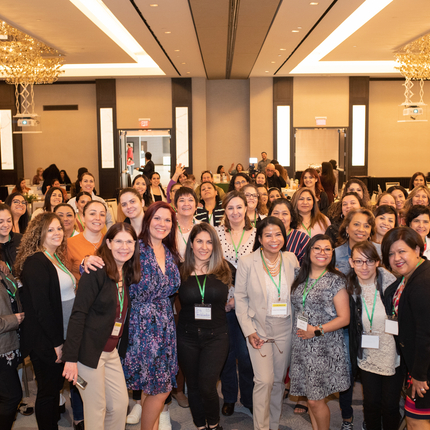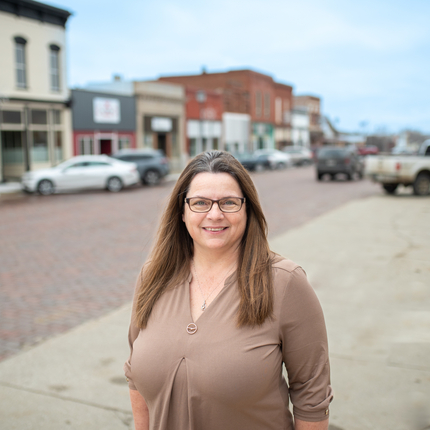Para la versión en español, oprima aquí.
The Center for Rural Affairs’ mission to establish strong rural communities continues with the Lending Services program, which today includes small business and housing loans as well as small business training and one-on-one assistance.
Small business development at the Center started in 1990 with a program (then called the Rural Enterprise Assistance Project, or REAP) that provided loans, training, and business planning assistance to rural microenterprises, or businesses with no more than 10 employees.
“Small businesses are the heart and soul of community development,” said Kim Preston, Lending Services director. “A strong business sector helps to generate much-needed economic growth and stability in the community. As many folks in rural communities find themselves working outside of town, they end up spending their money outside of town. Plugging this leak of dollars flowing out of the community is crucial as is the development of good businesses (that will spend money with other small businesses).”
The program evolved with the addition of a Women’s Business Center in 2001, then an added focus on Latino small businesses in 2004. In 2013, the Center became a community-development financial institution (CDFI) and was able to provide larger loans with an emphasis on serving Latinos and low-to-moderate income individuals.
In 2020, a housing loan program was established.
“Rural communities are full of housing that is inaccessible to many residents,” Kim said. “Banks will avoid offering mortgages to many of the properties where they will be found to be upside down in a collateral position. These homes are then left to deteriorate and become eyesores in the community. When the Center was able to add housing loans to our portfolio, we hoped to help address this need in our communities, and offer an opportunity for the homeowner to build a lifelong asset.”
Today, the maximum loan size for small business is $250,000, with loans available for working capital, small equipment and inventory purchases, and business real estate. Housing loans go up to $100,000 and are available for purchase or repair.
In late 2022, a new fund was created to serve small- and medium-sized meat processors with loans from $50,000 to $5 million.
“The very recent addition of meat processing capital offers even larger loans and capacity to assist more entrepreneurs than even our founders could have imagined,” Kim said. “I am excited to be a part of that growth.”
From policy assistant to Lending Services director
Kim is one of the longest-serving staff members at the Center, beginning her tenure in 1999. She was fresh out of college, newly married, and had a 1-year-old daughter. Her degree was in elementary and early childhood education, but she hadn’t taken the necessary classes for a Nebraska certificate.
“I was open to just about anything I could do using my experience and knowledge,” Kim said. “I found the job description for a policy assistant while searching for education-related jobs, as the main focus of the job was state education finance policy. I applied thinking there was no chance I was qualified, but the Center was 15 minutes away and it could be a good job to fill a gap until I found something that suited my education better.”
She was offered the position, and, as they say, the rest is history.
Kim worked to train others on the legislative process, securing testimony, and providing feedback on related policy developments. She helped write several reports on the inadequacies of rural school finance and held legislators accountable to their constituents in rural Nebraska.
The Center then moved its focus, as well as Kim’s work, to property tax relief measures, poverty reduction policies, value-added agriculture, small business development, health care and Nebraska’s Initiative 300, an anti-corporate farming measure.
“By this time, I felt comfortable in the direction my job was taking me and it was starting to feel a bit more like a career,” Kim said. “I would have to attribute that to the great leadership at the Center who was always willing to teach me, listen to my endless questions, and develop me into an asset.”
After about 15 years, Kim joined the lending program as an administrative assistant to service new and existing loans.
“I welcomed the challenge to be a part of something bigger that would leave a direct impact on the lives of rural communities and their businesses.” she said.
In 2018, Kim was asked to lead the Women’s Business Center, then the entire lending program.
“This growth came from great leadership that allowed me to develop in a role that I wasn’t naturally inclined to do,” she said. “My love for the organization and my always ‘can do it’ attitude have led me to where I am today.”
She attributes her broad understanding of the entire organization and its workings to the multiple roles she has played.
“Starting at the entry level in the lending program gave me a good foundation on which to build my abilities and knowledge of the program and what a vision for growth could look like,” Kim said. “As Women’s Business Center director, I was able to focus on what our coaching and one-on-one counseling program should look like. I gained first-hand experience and knowledge on our funders and eventually enough experience to grow into the director of the program.”
Lending’s past, present, and future
While the lending program has grown at the Center, Kim said the organization does not work alone.
“Quite honestly, our rural communities are driving the work,” she said. “From the inside looking out, we can see some trends, but communications with those rural communities, their partners, residents, and business owners give us a perspective to assist where we are needed.”
This allows the Center to adapt its products and services to the needs of communities, which was evident during the COVID-19 pandemic when business development services were offered virtually. Staff were able to reach a broader audience and deliver services quickly since travel and distance weren’t barriers.
“We were able to rapidly jump in to assist businesses in their greatest time of need but also were able to slow down and take a step back to assess our work and how we help others,” Kim said. “We were also able to develop our mortgage loan product and the processes behind all of this work.”
Small business owners not only need funding, they also need training and one-on-one coaching, which the Center has provided at no cost since 1990
“Small businesses are hungry for training and coaching,” Kim said. “When an entrepreneur has an idea, they are often great at their idea/trade. However, proper business management is often overlooked. Our staff and contractors have the experience necessary to assist entrepreneurs as they start, grow, and transition their businesses.”
The Center’s work in lending will keep evolving, long into the future, she said.
“Lending Services continues to build products and services that directly impact entrepreneurs and homeowners and provides opportunities that expedite access to capital for those left out of traditional financing,” Kim said. “We are building capacity for businesses to increase assets, provide well-paying jobs, and transition to the next generation of entrepreneurs.”
Top photo: Since 1990, the Center has provided loans and training for small business owners, including this group of Latina entrepreneurs at a conference in 2022. | Photos by Kylie Kai
Bottom photo: Lending Services Director Kim Preston is building products and services that directly impact entrepreneurs and lawmakers.






